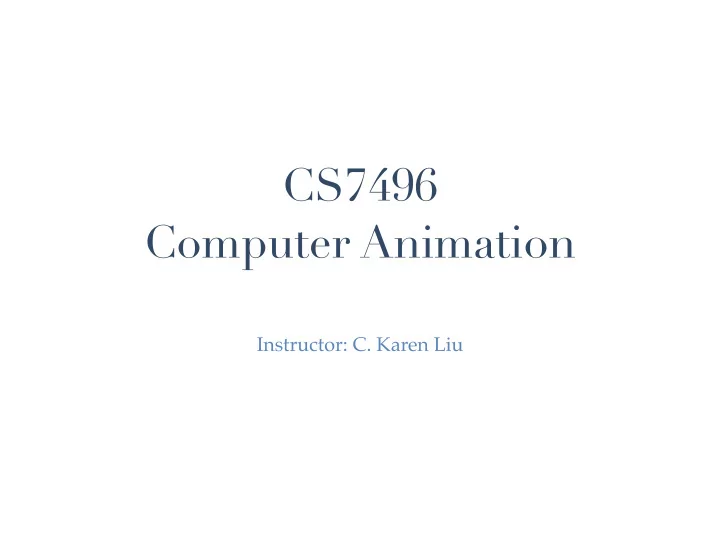

CS7496 Computer Animation Instructor: C. Karen Liu
Karen Liu Associate Professor at School of Interactive Computing
Karen Liu Associate Professor at School of Interactive Computing
Our TA: Vivek Trivedi
Administrations ✦ http://www.cc.gatech.edu/classes/AY2014/cs7496_fall/ � ✦ Course slides and projects are online. � ✦ No textbook, but there will be online reading materials. � ✦ Office hours: Tue 2-00-3:00, TSRB 230A. � ✦ TA office hours:
My goals ✦ To introduce basic techniques and math tools for simulation, analysis, and control of dynamic systems. � ✦ To teach you how to find and formulate your research problems. � ✦ To inspire some of you to do research in computer graphics, robotics, or biomechanics.
You will learn how to… ✦ simulate particles, rigid bodies, articulated rigid bodies, deformable objects, fluids, cloth. � ✦ numerical integration of ODEs, rigid body dynamics, constrained systems, collision detection and handling, Lagrangian dynamics, finite element methods, fluid mechanics. � ✦ motion synthesis of locomotion, hand manipulation, facial animation, skin/muscle deformation. � ✦ optimization methods, optimal control theory, biped balance control, manipulation control, reinforcement learning, skinning techniques, motion capture.
You will not learn… ✦ how to use commercial animation tools such as Maya. � ✦ how to use game engines such as Unity. � ✦ how to render high quality animation.
Prerequisites ✦ Thorough understanding of linear algebra. � ✦ Vector calculus. � ✦ Proficient in C++. � ✦ No need to have background in graphics.
Grading ✦ Reading assignments (15%) � ✦ Four mini projects (60%) � ✦ Final project (25%) � ✦ Quiz (0%)*
Reading assignments ✦ We will read ~10 research papers. � ✦ Each paper will be presented by a group of 2-3 students. � ✦ For each paper, everyone will write a short review before the presentation. � ✦ Send me your top 3 papers before next Monday. I’ll do the matching and scheduling. First come first serve!
Projects ✦ Project 1: Particles. � ✦ Project 2: Rigid body blender. � ✦ Project 3: Fun with fluid. � ✦ Project 4: Twister. � ✦ Final project: Something about control. � ✦ Late policy: 25% reduction per day if you don’t have a good reason. � ✦ Everything has to be turned in before 12 pm on the due date.
Final Project ✦ Something about control. � ✦ Balance. � ✦ Free throw. � ✦ The elevator. � ✦ Work with one partner on the final project.
Quiz ✦ Quiz will be given and discussed in class from time to time. � ✦ For every topic, expect 2-4 problems.
Introduction ✦ Simulate dynamic systems. � ✦ Control dynamic systems.
Physics simulation ✦ An algorithm that produces a sequence of states over time under the laws of physics. � ✦ What is a state?
Simulation x i x i +1 x i x i +1 = x i + ∆ x ∆ x
Simulation x i Newtonian laws gravity x i +1 wind gust x i elastic force… integrator x i +1 = x i + ∆ x ∆ x
Ordinary differential equations An ODE is an equation involving a function and its derivatives. known function x ( t ) = f ( x ( t )) ˙ time derivative of the unknown function that unknown function evaluates the state given time F = ma
Quiz ✦ What function does the black box represent? 1. x 2. ˙ x f 3.
Solving ODE ✦ Standard introductory differential equation courses focus on finding solutions analytically. � ✦ Linear ODEs can be solved by integral transforms. � ✦ We will learn how to solve an ODE numerically in this class.
Rigid bodies
Rigid bodies
Articulated rigid bodies
Deformable bodies
Deformable bodies
Plastic materials
Fluids
Fluids
Fluids
Fluids
Cloth
Cloth
Fluids + Solids
Fluids + Cloth
Melted
Drowned
Immolated
Waterboarded
Skewered
Crushed
Mutilated
Introduction ✦ Simulate dynamic systems. � ✦ Control dynamic systems.
Control rigid bodies Popovic et al, 2001
Control rigid bodies
Control rigid bodies
Control fluids
Control fluids
Control virtual humans
Why is this hard? ✦ Human musculoskeletal system has a large number of degrees of freedom and nonlinear dynamics � ✦ The control mechanism must be robust to operate in complex world. � ✦ No qualitative ways to measure “Naturalness”
Human motion
Without control
Why is this hard? ✦ Human musculoskeletal system has a large number of degrees of freedom and nonlinear dynamics � ✦ The control mechanism must be robust to operate in complex world. � ✦ No qualitative ways to measure “Naturalness”
Complex animals movements
Simulation x i Newtonian laws gravity x i +1 wind gust x i elastic force… integrator x i +1 = x i + ∆ x ∆ x
Simulation x i Newtonian laws gravity x i +1 wind gust elastic force… integrator ∆ x
Simulation + Control x i Newtonian laws gravity x i +1 contact force muscle force… integrator ∆ x
Physics approach
Physics approach
Physics approach
Why is this hard? ✦ Human musculoskeletal system has a large number of degrees of freedom and nonlinear dynamics � ✦ The control mechanism must be robust to operate in complex world. � ✦ No qualitative ways to measure “Naturalness”
Data-driven approach ✦ Use captured data to synthesize and interpolate new motions. � ✦ Preserve detailed nuances of human movements in the real world. � ✦ Produce stable and compelling animations in real-time.
Motion capture ✦ Many different approaches. Our lab has an optical based system. � ✦ Multiple infrared cameras. � ✦ High temporal resolution (1000+ fps). � ✦ Detect the locations of reflective markers.
Raw data from mocap ✦ Capture 3D positions of the markers. � ✦ Require inverse kinematics post-processing to produce animation represented as joint angle trajectories.
Final motion
Skinning
Facial animation
Recommend
More recommend